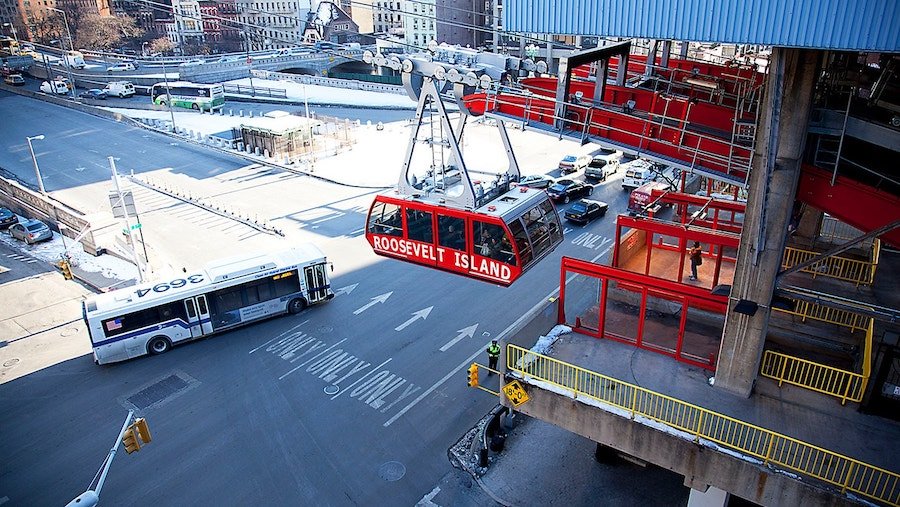Future Transport Is Aerial, but Not How You May Think: How "Sky Trams" Are Shaping Society

If you've ever been skiing in Colorado or visited certain parts of New York, you know what I'm talking about. Heck, New Mexico is home to the third-longest "cable-transport system" in the world, Sandia Peak, and so, all this got me thinking: what is the future of transportation actually shaped like?
First and foremost, we need to take a closer look at where these systems are employed and why, and as I explored aerial cable cars and the way they work, I noticed a trend: these babies are often used in mountainous and hilly areas, and not so much on flat expanses of ground.
Well, the very idea behind the aerial lift system (ropeway) was thought back in the 1600s by Croatian polymath Fausto Veranzio, and by 1644, the first working system was in place, and like most other inventions to ever appear, it was the first used by the military to build defenses. Oh, and don't confuse today's topic with another type of cable car, the rail-guided one devised by Andrew Smith Hallidie for San Franciso back in 1873.
Fast forward a couple of hundred years, and another European nation would see the second aerial cable car, Germany, but this time around, steel would finally be a part of the equation. Push the forward button a tad more, and these days, Bolivia, India, China, the US, and Europe seem to have the highest concentration of these aerial systems, and with good reason: the benefits of aerial and cable-driven transport cars seem to greatly outweigh their downsides, if any.
Let's start off with how such a system is devised. First of all, a ropeway system, in its most basic iteration, consists of a drivewheel, a bullwheel, and one continuous loop of cable, with the obvious gondolas spaced out along the 'string' of steel. Oh, and only the drivewheel is powered and consuming energy for these trips.
How much energy? This is where I was blown away. On average, a ropeway will consume only 0.1 kWh of power to move around one person one kilometer in one direction...what!? That's 86 calories for you and me, and if I'm not mistaken, there are more calories in a friggin Snickers! Yup, 488 calories per 100 grams in the timeless caramel goodness, and a bar weighs around 50 grams. In short, the energy needed to move you with an air gondola is around how much you'd find in a bite of Snickers. With that in mind, I feel it's safe to say that we may be going about this whole EV wave all wrong.
Now, all those gondolas, some of which can carry up to 60 passengers or more each, move around the clock, carrying people to and from destinations like conveyor belts in a Chinese factory. Just to give you an idea of how many people use these things, according to our sources at Leitner-Poma, one of America's leading designers, manufacturers, and installation specialists of ropeways brags about their systems being responsible for a traveling capacity of 8 million people per hour. Think about that for a second. Their work can be spotted in 61 countries worldwide.
The question now remains as to why not every city in the world is employing these systems. Well, there are several factors, one of which still remains to be the current personal vehicle wave that we've been caught up in for decades. We love the privacy of our cars and motorcycles and the ability to roam freely.
Up next, we have terrain. Simply put, most cities would need to make changes to their current infrastructures to implement such systems. I'm sure you've seen the network of pylons and cables that accompany such alternative transportation systems.
Well, not all cities can handle or want to handle the changes needed to add a better way to travel, not to mention all those underlying business contracts that could be lost while adopting a ropeway; wink-wink.
In the long-term, it would be better, but we want our profits now, not in ten to 15 years. High initial investment costs also don't help ropeways get off the proverbial ground. Then there's weather dependency, problems that seem to be solved by the current cars we drive and lease, for now, anyway.
This brings me to the future of this industry: where is it headed? Well, there's big business in this timeless way of traveling, and sources even say that this industry is potentially billions of dollars. We just need to start making a shift in thinking and moving through our urban jungles.
Speaking of such shifts, countries and cities that have adopted this method of transport have seen considerable effects on their residents. According to a paper on the impact of aerial cable cars in La Paz, Bolivia, residents actually ditched their personal vehicles in favor of ropeways. It might have something to do with floating high above the rest of the city in a virtually silent transportation system; don't mind the occasional squeak.
Oh, and we're also getting better and faster at building ingenious ways to help cut costs, fully automate such systems, and get them in place sooner rather than later. We just need to see things a bit differently, and with a bit of pushing, the future is sure to be aerial, just not how you might have thought.
Clearly, these aren't the only factors in the success or lack thereof for ropeways, so feel free to share how you feel about this industry, where it's headed, and why things are the way they are.
Related News


